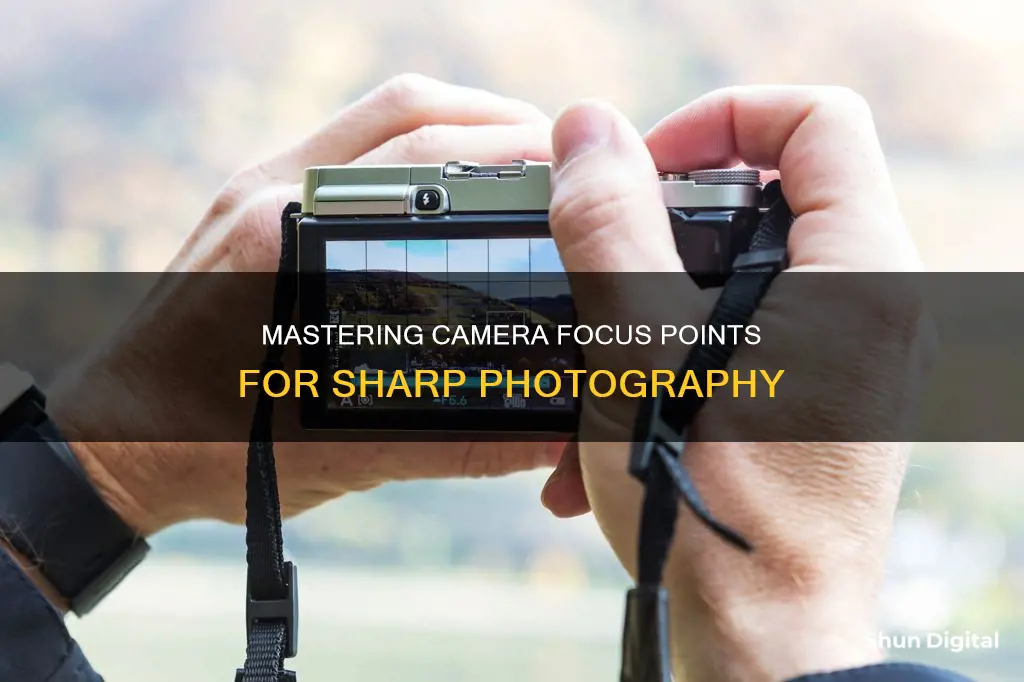
Focus points are what your camera uses to focus. They are the dots around the frame that your camera uses to focus and can be active or inactive. Active focus points are used by the camera to acquire focus, while inactive focus points can be activated by changing the AF area mode. The number of focus points offered by a camera depends on the specific model. More focus points generally enhance focusing capability. Your autofocus points are generally most noticeable when you press the shutter halfway. At this point, your camera might emit a beep, and some of the AF points usually blink a different light. These are the areas where your camera is automatically focusing on.
| Characteristics | Values |
|---|---|
| Number of focus points | Modern cameras offer anywhere from 5 to over 75 focus points. |
| Type of focus points | Standard and cross-type. Cross-type points are more advanced and accurate. |
| Autofocus modes | Single-shot (still subjects), continuous/tracking (moving subjects), and hybrid. |
| AF area modes | Single-point, dynamic area, and zone. |
| Camera focus | Cameras can either focus on a single specific point or all points at once. |
What You'll Learn

Focus points are dots around the frame that your camera uses to focus
Focus points are an essential aspect of modern photography, allowing photographers to capture stunning, well-focused images. These focus points are represented as dots around the frame of the camera's viewfinder or LCD screen. They serve as a visual indication of what the camera is focusing on, helping photographers ensure their desired subjects are in sharp focus.
The number of focus points varies across different camera models, with modern systems offering anywhere from a dozen to several dozen or even hundreds of points. This range is influenced by the type of autofocus system employed, with on-sensor systems capable of providing a much higher number of focus points compared to separate autofocus systems. Having more focus points enhances the camera's focusing capability, providing photographers with greater precision and control over their images.
Photographers can choose to manually select a single focus point, often located at the centre of the frame, to ensure their subject remains in focus. This is particularly useful when dealing with still subjects, as the focus can be locked by partially depressing the shutter button before recomposing and capturing the shot. Alternatively, when photographing moving subjects, utilising autofocus modes like continuous AF or AI Servo can help keep the subject in focus by predicting its movement and continuously readjusting the focus.
Different types of focus points, such as standard and cross-type, also offer varying levels of accuracy and performance. Cross-type focus points, for instance, are more advanced as they observe the scene along both vertical and horizontal axes, making them faster and more accurate in acquiring focus.
By understanding the behaviour of focus points and utilising the various autofocus modes and area modes, photographers can master the art of capturing well-composed, sharp images, regardless of whether their subjects are still or in motion.
Focusing Your Droid Moto Z Camera: Tips and Tricks
You may want to see also

Autofocusing allows photographers to focus on composition and lighting
Autofocusing is a feature in most modern cameras that allows the camera to adjust its lens to focus on a particular subject. This is done through either active or passive autofocus systems. Active autofocus systems emit a signal to estimate the distance to the subject and adjust the focus accordingly. On the other hand, passive autofocus systems, which are more common, rely solely on data coming into the camera and use phase detection or contrast detection methods to achieve accurate focus.
The advantage of autofocusing is that it allows photographers to focus on other aspects of photography, such as composition and lighting. Composition refers to the arrangement of elements within a photograph, including the rule of thirds, balance, and symmetry. By using autofocus, photographers can pay more attention to the placement of their subjects and the overall visual appeal of the image.
Additionally, autofocus can help photographers achieve the desired lighting and exposure in their photographs. By locking the focus on a specific point, photographers can then adjust the lighting and exposure settings to ensure the image is correctly exposed. This is especially useful in low-light or high-contrast situations, where autofocus can help achieve the desired lighting effects.
While autofocus is a convenient tool, it is important to note that it may not always produce the desired results. In such cases, manual focus can be used, where the photographer has complete control over the focus by adjusting the focus ring on the lens. However, this requires practice and skill to master, as it relies on the photographer's eye and hand coordination.
In conclusion, autofocusing in cameras has revolutionized photography by allowing photographers to concentrate on composition and lighting while still achieving sharp focus on their desired subjects. By understanding how autofocus works and knowing when to use it effectively, photographers can enhance their creative vision and capture stunning images with ease.
Focusing Line Scan Cameras: Tips for Optimal Performance
You may want to see also

Autofocus points can be active or inactive
The number of autofocus points varies by camera model, with modern systems offering anywhere from a dozen to hundreds of points. More autofocus points generally enhance focusing capability.
There are two types of autofocus points: standard and cross-type. Cross-type autofocus points are more advanced and accurate than standard autofocus points. Cross-type autofocus points are two-dimensional and can detect contrast on both vertical and horizontal lines.
There are also different autofocus modes. Single-shot autofocus mode is used for still subjects, while continuous/tracking autofocus mode is used for moving subjects.
Different autofocus area modes determine how the autofocus points are used to achieve focus. Single-point autofocus area mode allows you to select just one autofocus point, giving you pinpoint accuracy. Dynamic area autofocus area mode allows you to choose between 9, 21, and 51-point placements, with the selected number of autofocus points used in combination to achieve focus. 3D tracking autofocus area mode attempts to find and follow a moving subject, adjusting the autofocus point as it goes.
Body-Cam Battery Life: How Long Does It Last?
You may want to see also

There are standard and cross-type focus points
When you look through the viewfinder of a DSLR camera, you will see several dots or squares that represent the individual points at which the camera can focus. These are called focus points. The number of focus points varies across cameras, ranging from 5 to 75 or more. You can select either a specific point or all points at once for autofocusing.
Now, there are two types of focus points: standard and cross-type. Standard focus points work vertically only (single dimension), whereas cross-type points can focus on contrast changes both horizontally and vertically (two dimensions). Cross-type points are simply two linear sensors crossing each other, forming a cross shape. This makes them superior to standard focus points as they can work with both vertical and horizontal light patterns.
Most high-end DSLR models, such as the Nikon D5 or Canon 5D Mark III, have several clusters of cross-type focusing sensors. On the other hand, lower-end models, like the Nikon D3200 and Canon Rebel T3i, usually have just one cross-type sensor in the centre. This means that the autofocus in the centre will likely be faster and more reliable than the points on the edge.
The advantage of cross-type focus points is their ability to handle a wider variety of situations. They are not necessarily faster or more accurate but can successfully deal with more complex scenes. For example, if you have only vertical lines in your scene and try to use a vertical focus point (optimised for horizontal lines), it will struggle to focus. However, if you have horizontal lines, you won't notice a significant difference between using a vertical focus point or a cross-type point.
Portrait, family, and wedding photographers often use the focus-and-recompose method. They first nail the focus with a cross-type sensor and then shift the camera's field of view to get the desired composition. Landscape photographers might not need speedy autofocus, but using cross-type sensors can help ensure more accurate focus.
The Power of Wyze Cameras: Battery or Plug-in?
You may want to see also

Autofocus modes include single-shot and continuous/tracking
Autofocus modes are an essential feature of modern cameras, allowing photographers to capture images with perfect focus. The two main autofocus modes are single-shot and continuous/tracking autofocus.
Single-shot autofocus, also known as AF-S (Nikon), One-Shot AF (Canon), or Single-Shot AF (Sony), is ideal for stationary subjects. When using this mode, the photographer selects a focus point, and the camera focuses on that point once. The focus remains locked, even if the subject moves, until the shutter is pressed or autofocus is re-engaged. This mode is perfect for portraits, landscapes, still life, and other static subjects. It also saves battery power compared to continuous autofocus.
Continuous autofocus, also known as AF-C (Nikon and Sony) or AI Servo AF (Canon), is designed for capturing moving subjects. In this mode, the camera continually adjusts its focus to track the subject's movement. The photographer selects a focus point, and as long as they keep the shutter button pressed halfway, the camera keeps the subject in focus. This mode is excellent for sports photography, wildlife photography, and any situation involving moving subjects. However, it uses more battery power than single-shot autofocus.
Some cameras also offer a hybrid autofocus mode, often called AF-A (Nikon) or AI Focus AF (Canon). This mode automatically switches between single-shot and continuous autofocus, depending on the subject's movement. It is useful for beginners or situations where the subject's movement is unpredictable.
Understanding Browning Trail Camera's Dark Mode Feature
You may want to see also
Frequently asked questions
Focus points are what your camera uses to focus. They are the points in the camera's view that it can choose to focus on. They are usually denoted by small squares or dots around the frame.
You can manually select a focus point by using the AF Point selection button or by going into your camera's menu. You can also use the wheels or arrow keys on the back of your camera to toggle between focus points.
The number of focus points offered by a camera depends on the specific model, and more focus points generally enhance focusing capability. Modern systems can offer anywhere from a dozen to hundreds of points.
There are two main types of focus points: standard and cross-type. Cross-type points are more advanced, accurate, and faster at acquiring focus.
When shooting moving subjects, it is recommended to use AF-C (AI-Servo) mode, which will keep the subject in focus by continuously acquiring focus. You can also use AF tracking modes, which will follow your subject around the frame.







